Modular Polymerase Synthesis and Internal Protein Domain Swapping via Dual Opposed Frameshifts in the Ebola Virus L Gene
Abstract
1. Introduction
1.1. Mechanisms of Ribosomal Frameshifting
1.2. Antisense Tethering Interactions
1.3. Internal Protein Domain Swapping Encoded by Dual Opposed Programmed Frameshifts
2. Materials and Methods
2.1. Sequence Analysis and Assessment of Antisense Matches
2.2. Gel Mobility Shift Assay
2.3. Frameshift Construct Design
- 5′AAGCTTAACATTTGTACATTCAGGTTTTATCTATTTTGGAAAAAAACAATATTTGAATGGGGTCCAATTGCCTCAGTCCCTTAAAACGGCTACAAGAATGGCACCATTGTCTGATGCAATTTTTGATGATCTTCAAGGGACCCTGGCTAGTATAGGCACTGCTTTTGAGCGATCCATCGAATTC3′
- 5′AAGCTTAACATTTGTACATTCAGGTTTTATCTATTTTGGAAAAAAACAATATTTGAATGGGGTCCAATTGCCTCAGTCCCTAAAACGGCTACAAGAATGGCACCATTGTCTGATGCAATTTTTGATGATCTTCAAGGGACCCTGGCTAGTATAGGCACTGCTTTTGAGCGATCCATCGAATTC3′
2.4. Plasmid Propagation
2.5. Transfection Protocol
2.6. Reporter Gene Assay
2.7. Modeling of EBOV L Gene Protein Frameshift Isoforms Using AlphaFold2
3. Results and Discussion
3.1. Identification of EBOV L Gene -1 Frameshift Site and Antisense Complementarity to DIO2
3.2. In Vitro Assessment of the Predicted Antisense Interaction
3.3. Frameshift Site Validation
3.4. Predicted L Protein Isoforms Resulting from Possible Frameshifting and Stop Codon Readthrough
3.5. Assessment of Structural Feasibility and Functional Implications of the Predicted Frameshift Isoforms via Protein Modeling Using AlphaFold2
3.6. Potential Redox Function of the Frameshift-Encoded Module
3.7. A Critical Hinge Function in Polymerase Motif E Is Duplicated within the Frameshift Module
3.8. Genomic Sequences Required for Expression of Frameshift Variants Are Highly Conserved in EBOV
3.9. Tissue Distribution of DIO2 Overlaps with Sites Relevant for Ebola Pathogenesis
3.10. Redox Biology as a Double-Edged Sword for Both Virus and Host, and the Danger of RNA Oxidation
4. Conclusions and Significance
Supplementary Materials
Author Contributions
Funding
Institutional Review Board Statement
Informed Consent Statement
Data Availability Statement
Conflicts of Interest
References
- Report of an International Commission. Ebola Haemorrhagic Fever in Zaire: 1976. Bull. World Health Organ. 1978, 56, 271–293. [Google Scholar]
- Letafati, A.; Salahi Ardekani, O.; Karami, H.; Soleimani, M. Ebola virus disease: A narrative review. Microb. Pathog. 2023, 181, 106213. [Google Scholar] [CrossRef] [PubMed]
- Sanjuán, R.; Nebot, M.R.; Chirico, N.; Mansky, L.M.; Belshaw, R. Viral Mutation Rates. J. Virol. 2010, 84, 9733–9748. [Google Scholar] [CrossRef]
- Feldmann, H.; Klenk, H.D. Marburg and Ebola Viruses. Adv. Virus Res. 1996, 47, 1–52. [Google Scholar] [CrossRef] [PubMed]
- Whelan, S.P.J.; Barr, J.N.; Wertz, G.W. Transcription and Replication of Nonsegmented Negative-Strand RNA Viruses. Curr. Top. Microbiol. Immunol. 2004, 283, 61–119. [Google Scholar] [CrossRef]
- Taylor, E.W.; Ruzicka, J.A.; Premadasa, L.; Zhao, L. Cellular Selenoprotein mRNA Tethering via Antisense Interactions with Ebola and HIV-1 mRNAs May Impact Host Selenium Biochemistry. Curr. Top. Med. Chem. 2016, 16, 1530–1535. [Google Scholar] [CrossRef]
- Taylor, E.W.; Ruzicka, J.A.; Preamadasa, L. Translational Readthrough of the Ebola Nucleoprotein 3’-UGA Codon via Antisense Tethering of Thioredoxin Reductase 3 mRNA. In Proceedings of the International Congress on Targeting Ebola, Paris, France, 28–29 May 2015. [Google Scholar] [CrossRef]
- Premadasa, L.; Dailey, G.; Ruzicka, J.A.; Taylor, E.W. Selenium-Dependent Read Through of the Conserved 3’-Terminal UGA Stop Codon of HIV-1 nef. Am. J. Biopharm. Pharm. Sci. 2021, 1, 1. [Google Scholar] [CrossRef]
- Taylor, E.W.; Cox, A.G.; Zhao, L.; Ruzicka, J.A.; Bhat, A.A.; Zhang, W.; Nadimpalli, R.G.; Dean, R.G. Nutrition, HIV, and Drug Abuse: The Molecular Basis of a Unique Role for Selenium. J. Acquir. Immune Defic. Syndr. 2000, 25, S53–S61. [Google Scholar] [CrossRef]
- Zhao, L.; Cox, A.G.; Ruzicka, J.A.; Bhat, A.A.; Zhang, W.; Taylor, E.W. Molecular Modeling and in vitro Activity of an HIV-1-Encoded Glutathione Peroxidase. Proc. Natl. Acad. Sci. USA 2000, 97, 6356–6361. [Google Scholar] [CrossRef]
- Zhang, W.; Ramanathan, C.S.; Nadimpalli, R.G.; Bhat, A.A.; Cox, A.G.; Taylor, E.W. Selenium-Dependent Glutathione Peroxidase Modules Encoded by RNA Viruses. Biol. Trace Elem. Res. 1999, 70, 97–116. [Google Scholar] [CrossRef]
- Volchkov, V.E.; Volchkova, V.A.; Chepurnov, A.A.; Blinov, V.M.; Dolnik, O.; Netesov, S.V.; Feldmann, H. Characterization of the L Gene and 5h Trailer Region of Ebola Virus. J. Gen. Virol. 1999, 80, 355–362. [Google Scholar] [CrossRef] [PubMed]
- Jacks, T.; Varmus, H.E. Expression of the Rous Sarcoma Virus Pol Gene by Ribosomal Frameshifting. Science 1985, 230, 1237–1242. [Google Scholar] [CrossRef] [PubMed]
- Jacks, T.; Power, M.D.; Masiarz, F.R.; Luciw, P.A.; Barr, P.J.; Varmus, H.E. Characterization of Ribosomal Frameshifting in HIV-1 Gag-Pol Expression. Nature 1988, 331, 280–283. [Google Scholar] [CrossRef]
- Choi, J.; O’Loughlin, S.; Atkins, J.F.; Puglisi, J.D. The Energy Landscape of −1 Ribosomal Frameshifting. Sci. Adv. 2020, 6, eaax6969. [Google Scholar] [CrossRef]
- Olubajo, B.; Taylor, E.W. A −1 Frameshift in the HIV-1 Env Gene Is Enhanced by Arginine Deficiency via a Hungry Codon Mechanism. Mutat. Res. 2005, 579, 125–132. [Google Scholar] [CrossRef]
- Cao, S.; Chen, S.-J. Predicting Ribosomal Frameshifting Efficiency. Phys. Biol. 2008, 5, 16002. [Google Scholar] [CrossRef]
- Green, L.; Kim, C.-H.; Bustamante, C.; Tinoco, I. Characterization of the Mechanical Unfolding of RNA Pseudoknots. J. Mol. Biol. 2008, 375, 511–528. [Google Scholar] [CrossRef] [PubMed]
- Lin, Z.; Gilbert, R.J.C.; Brierley, I. Spacer-Length Dependence of Programmed −1 or −2 Ribosomal Frameshifting on a U6A Heptamer Supports a Role for Messenger RNA (mRNA) Tension in Frameshifting. Nucleic Acids Res. 2012, 40, 8674–8689. [Google Scholar] [CrossRef]
- Taylor, E.W. Sequence Analysis Reveals a −1 Ribosomal Frameshift Site in the Zaire Ebolavirus Polymerase Gene in a Region with Antisense Complementarity to a Human Selenoprotein mRNA. Figshare 2014. Preprint. [Google Scholar] [CrossRef]
- Rodnina, M.V.; Korniy, N.; Klimova, M.; Karki, P.; Peng, B.-Z.; Senyushkina, T.; Belardinelli, R.; Maracci, C.; Wohlgemuth, I.; Samatova, E.; et al. Translational Recoding: Canonical Translation Mechanisms Reinterpreted. Nucleic Acids Res. 2020, 48, 1056–1067. [Google Scholar] [CrossRef]
- Atkins, J.F.; Loughran, G.; Bhatt, P.R.; Firth, A.E.; Baranov, P.V. Ribosomal Frameshifting and Transcriptional Slippage: From Genetic Steganography and Cryptography to Adventitious Use. Nucleic Acids Res. 2016, 44, 7007–7078. [Google Scholar] [CrossRef] [PubMed]
- Advani, V.M.; Dinman, J.D. Reprogramming the Genetic Code: The Emerging Role of Ribosomal Frameshifting in Regulating Cellular Gene Expression. BioEssays 2016, 38, 21–26. [Google Scholar] [CrossRef]
- Dinman, J.D.; Ruiz-Echevarria, M.J.; Peltz, S.W. Translating Old Drugs into New Treatments: Ribosomal Frameshifting as a Target for Antiviral Agents. Trends Biotechnol. 1998, 16, 190–196. [Google Scholar] [CrossRef]
- Firth, A.E.; Brierley, I. Non-Canonical Translation in RNA Viruses. J. Gen. Virol. 2012, 93, 1385–1409. [Google Scholar] [CrossRef] [PubMed]
- Theis, C.; Reeder, J.; Giegerich, R. KnotInFrame: Prediction of −1 Ribosomal Frameshift Events. Nucleic Acids Res. 2008, 36, 6013–6020. [Google Scholar] [CrossRef]
- Skalsky, R.L.; Cullen, B.R. Viruses, microRNAs, and Host Interactions. Annu. Rev. Microbiol. 2010, 64, 123–141. [Google Scholar] [CrossRef]
- Lei, L.; Cheng, A.; Wang, M.; Jia, R. The Influence of Host miRNA Binding to RNA Within RNA Viruses on Virus Multiplication. Front. Cell. Infect. Microbiol. 2022, 12, 802149. [Google Scholar] [CrossRef] [PubMed]
- Taylor, E.W. RNA Viruses vs. DNA Synthesis: A General Viral Strategy That May Contribute to the Protective Antiviral Effects of Selenium. 2020; Preprints. [Google Scholar] [CrossRef]
- Howard, M.T.; Gesteland, R.F.; Atkins, J.F. Efficient Stimulation of Site-Specific Ribosome Frameshifting by Antisense Oligonucleotides. RNA 2004, 10, 1653–1661. [Google Scholar] [CrossRef]
- Henderson, C.M.; Anderson, C.B.; Howard, M.T. Antisense-Induced Ribosomal Frameshifting. Nucleic Acids Res. 2006, 34, 4302–4310. [Google Scholar] [CrossRef]
- Ishimaru, D.; Plant, E.P.; Sims, A.C.; Yount, B.L.; Roth, B.M.; Eldho, N.V.; Pérez-Alvarado, G.C.; Armbruster, D.W.; Baric, R.S.; Dinman, J.D.; et al. RNA Dimerization Plays a Role in Ribosomal Frameshifting of the SARS Coronavirus. Nucleic Acids Res. 2013, 41, 2594–2608. [Google Scholar] [CrossRef]
- De Smit, M.H.; Van Duin, J.; Van Knippenberg, P.H.; Van Eijk, H.G. CCC.UGA: A New Site of Ribosomal Frameshifting in Escherichia Coli. Gene 1994, 143, 43–47. [Google Scholar] [CrossRef] [PubMed][Green Version]
- Jumper, J.; Evans, R.; Pritzel, A.; Green, T.; Figurnov, M.; Ronneberger, O.; Tunyasuvunakool, K.; Bates, R.; Žídek, A.; Potapenko, A.; et al. Highly Accurate Protein Structure Prediction with AlphaFold. Nature 2021, 596, 583–589. [Google Scholar] [CrossRef] [PubMed]
- Rehmsmeier, M.; Steffen, P.; Hochsmann, M.; Giegerich, R. Fast and Effective Prediction of microRNA/Target Duplexes. RNA 2004, 10, 1507–1517. [Google Scholar] [CrossRef]
- Grentzmann, G.; Ingram, J.A.; Kelly, P.J.; Gesteland, R.F.; Atkins, J.F. A Dual-Luciferase Reporter System for Studying Recoding Signals. RNA 1998, 4, 479–486. [Google Scholar]
- Mirdita, M.; Schütze, K.; Moriwaki, Y.; Heo, L.; Ovchinnikov, S.; Steinegger, M. ColabFold-Making Protein Folding Accessible to All. Nat. Methods 2022, 19, 679–682. [Google Scholar] [CrossRef]
- Liang, B. Structures of the Mononegavirales Polymerases. J. Virol. 2020, 94, e00175-20. [Google Scholar] [CrossRef] [PubMed]
- Tchesnokov, E.P.; Raeisimakiani, P.; Ngure, M.; Marchant, D.; Götte, M. Recombinant RNA-Dependent RNA Polymerase Complex of Ebola Virus. Sci. Rep. 2018, 8, 3970. [Google Scholar] [CrossRef]
- Gladyshev, V.N.; Jeang, K.T.; Stadtman, T.C. Selenocysteine, Identified as the Penultimate C-Terminal Residue in Human T-Cell Thioredoxin Reductase, Corresponds to TGA in the Human Placental Gene. Proc. Natl. Acad. Sci. USA 1996, 93, 6146–6151. [Google Scholar] [CrossRef]
- Shimodaira, S.; Iwaoka, M. Synthesis of Selenocysteine-Containing Dipeptides Modeling the Active Site of Thioredoxin Reductase. Phosphorus Sulfur Silicon Relat. Elem. 2019, 194, 750–752. [Google Scholar] [CrossRef]
- Xu, X.-M.; Turanov, A.A.; Carlson, B.A.; Yoo, M.-H.; Everley, R.A.; Nandakumar, R.; Sorokina, I.; Gygi, S.P.; Gladyshev, V.N.; Hatfield, D.L. Targeted Insertion of Cysteine by Decoding UGA Codons with Mammalian Selenocysteine Machinery. Proc. Natl. Acad. Sci. USA 2010, 107, 21430–21434. [Google Scholar] [CrossRef]
- Li, Z.; Malla, S.; Shin, B.; Li, J.M. Battle against RNA Oxidation: Molecular Mechanisms for Reducing Oxidized RNA to Protect Cells. WIREs RNA 2014, 5, 335–346. [Google Scholar] [CrossRef] [PubMed]
- Nelson, K.J.; Knutson, S.T.; Soito, L.; Klomsiri, C.; Poole, L.B.; Fetrow, J.S. Analysis of the Peroxiredoxin Family: Using Active-site Structure and Sequence Information for Global Classification and Residue Analysis. Proteins Struct. Funct. Bioinforma. 2011, 79, 947–964. [Google Scholar] [CrossRef]
- Sabatino, L.; Vassalle, C.; Del Seppia, C.; Iervasi, G. Deiodinases and the Three Types of Thyroid Hormone Deiodination Reactions. Endocrinol. Metab. 2021, 36, 952–964. [Google Scholar] [CrossRef] [PubMed]
- Amissah-Arthur, M.B.; Poller, B.; Tunbridge, A.; Adebajo, A. Musculoskeletal Manifestations of Ebola Virus. Rheumatology 2018, 57, 28–31. [Google Scholar] [CrossRef]
- Gourronc, F.A.; Rebagliati, M.R.; Kramer-Riesberg, B.; Fleck, A.M.; Patten, J.J.; Geohegan-Barek, K.; Messingham, K.N.; Davey, R.A.; Maury, W.; Klingelhutz, A.J. Adipocytes Are Susceptible to Ebola Virus Infection. Virology 2022, 573, 12–22. [Google Scholar] [CrossRef] [PubMed]
- Billioux, B.J.; Smith, B.; Nath, A. Neurological Complications of Ebola Virus Infection. Neurotherapeutics 2016, 13, 461–470. [Google Scholar] [CrossRef]
- Kwakkel, J.; Surovtseva, O.V.; De Vries, E.M.; Stap, J.; Fliers, E.; Boelen, A. A Novel Role for the Thyroid Hormone-Activating Enzyme Type 2 Deiodinase in the Inflammatory Response of Macrophages. Endocrinology 2014, 155, 2725–2734. [Google Scholar] [CrossRef]
- Van Der Spek, A.H.; Fliers, E.; Boelen, A. Thyroid Hormone Metabolism in Innate Immune Cells. J. Endocrinol. 2017, 232, R67–R81. [Google Scholar] [CrossRef]
- Van Der Spek, A.H.; Surovtseva, O.V.; Jim, K.K.; Van Oudenaren, A.; Brouwer, M.C.; Vandenbroucke-Grauls, C.M.J.E.; Leenen, P.J.M.; Van De Beek, D.; Hernandez, A.; Fliers, E.; et al. Regulation of Intracellular Triiodothyronine Is Essential for Optimal Macrophage Function. Endocrinology 2018, 159, 2241–2252. [Google Scholar] [CrossRef]
- Mahanty, S.; Bray, M. Pathogenesis of Filoviral Haemorrhagic Fevers. Lancet Infect. Dis. 2004, 4, 487–498. [Google Scholar] [CrossRef]
- Martinvalet, D.; Walch, M. Editorial: The Role of Reactive Oxygen Species in Protective Immunity. Front. Immunol. 2022, 12, 832946. [Google Scholar] [CrossRef] [PubMed]
- Biswas, S.K. Does the Interdependence between Oxidative Stress and Inflammation Explain the Antioxidant Paradox? Oxid. Med. Cell. Longev. 2016, 2016, 5698931. [Google Scholar] [CrossRef]
- Schwarz, K.B. Oxidative Stress during Viral Infection: A Review. Free Radic. Biol. Med. 1996, 21, 641–649. [Google Scholar] [CrossRef] [PubMed]
- Herzenberg, L.A.; De Rosa, S.C.; Dubs, J.G.; Roederer, M.; Anderson, M.T.; Ela, S.W.; Deresinski, S.C.; Herzenberg, L.A. Glutathione Deficiency Is Associated with Impaired Survival in HIV Disease. Proc. Natl. Acad. Sci. USA 1997, 94, 1967–1972. [Google Scholar] [CrossRef] [PubMed]
- Taylor, E.W. The Oxidative Stress-Induced Niacin Sink (OSINS) Model for HIV Pathogenesis. Toxicology 2010, 278, 124–130. [Google Scholar] [CrossRef] [PubMed]
- Khomich, O.A.; Kochetkov, S.N.; Bartosch, B.; Ivanov, A.V. Redox Biology of Respiratory Viral Infections. Viruses 2018, 10, 392. [Google Scholar] [CrossRef]
- Liu, M.; Chen, F.; Liu, T.; Chen, F.; Liu, S.; Yang, J. The Role of Oxidative Stress in Influenza Virus Infection. Microbes Infect. 2017, 19, 580–586. [Google Scholar] [CrossRef]
- Dobrzyńska, M.; Moniuszko-Malinowska, A.; Skrzydlewska, E. Metabolic Response to CNS Infection with Flaviviruses. J. Neuroinflamm. 2023, 20, 218. [Google Scholar] [CrossRef]
- Georgieva, E.; Ananiev, J.; Yovchev, Y.; Arabadzhiev, G.; Abrashev, H.; Abrasheva, D.; Atanasov, V.; Kostandieva, R.; Mitev, M.; Petkova-Parlapanska, K.; et al. COVID-19 Complications: Oxidative Stress, Inflammation, and Mitochondrial and Endothelial Dysfunction. Int. J. Mol. Sci. 2023, 24, 14876. [Google Scholar] [CrossRef]
- Eisfeld, A.J.; Halfmann, P.J.; Wendler, J.P.; Kyle, J.E.; Burnum-Johnson, K.E.; Peralta, Z.; Maemura, T.; Walters, K.B.; Watanabe, T.; Fukuyama, S.; et al. Multi-Platform ’Omics Analysis of Human Ebola Virus Disease Pathogenesis. Cell Host Microbe 2017, 22, 817–829.e8. [Google Scholar] [CrossRef]
- Kong, Q.; Lin, C.G. Oxidative Damage to RNA: Mechanisms, Consequences, and Diseases. Cell. Mol. Life Sci. 2010, 67, 1817–1829. [Google Scholar] [CrossRef] [PubMed]
- Senkevich, T.G.; Bugert, J.J.; Sisler, J.R.; Koonin, E.V.; Darai, G.; Moss, B. Genome Sequence of a Human Tumorigenic Poxvirus: Prediction of Specific Host Response-Evasion Genes. Science 1996, 273, 813–816. [Google Scholar] [CrossRef] [PubMed]
- Bratke, K.A.; McLysaght, A. Identification of Multiple Independent Horizontal Gene Transfers into Poxviruses Using a Comparative Genomics Approach. BMC Evol. Biol. 2008, 8, 67. [Google Scholar] [CrossRef]
- Edwards, M.R.; Johnson, B.; Mire, C.E.; Xu, W.; Shabman, R.S.; Speller, L.N.; Leung, D.W.; Geisbert, T.W.; Amarasinghe, G.K.; Basler, C.F. The Marburg Virus VP24 Protein Interacts with Keap1 to Activate the Cytoprotective Antioxidant Response Pathway. Cell Rep. 2014, 6, 1017–1025. [Google Scholar] [CrossRef] [PubMed]
- Wang, Y.; Huang, J.; Sun, Y.; Stubbs, D.; He, J.; Li, W.; Wang, F.; Liu, Z.; Ruzicka, J.A.; Taylor, E.W.; et al. SARS-CoV-2 Suppresses mRNA Expression of Selenoproteins Associated with Ferroptosis, Endoplasmic Reticulum Stress and DNA Synthesis. Food Chem. Toxicol. 2021, 153, 112286. [Google Scholar] [CrossRef]
- Gallardo, I.A.; Todd, D.A.; Lima, S.T.; Chekan, J.R.; Chiu, N.H.; Taylor, E.W. SARS-CoV-2 Main Protease Targets Host Selenoproteins and Glutathione Biosynthesis for Knockdown via Proteolysis, Potentially Disrupting the Thioredoxin and Glutaredoxin Redox Cycles. Antioxidants 2023, 12, 559. [Google Scholar] [CrossRef]
- Moghaddam, A.; Heller, R.; Sun, Q.; Seelig, J.; Cherkezov, A.; Seibert, L.; Hackler, J.; Seemann, P.; Diegmann, J.; Pilz, M.; et al. Selenium Deficiency Is Associated with Mortality Risk from COVID-19. Nutrients 2020, 12, 2098. [Google Scholar] [CrossRef]
- Rayman, M.P.; Taylor, E.W.; Zhang, J. The Relevance of Selenium to Viral Disease with Special Reference to SARS-CoV-2 and COVID-19. Proc. Nutr. Soc. 2022, 82, 1–12. [Google Scholar] [CrossRef]
- Dailey, G.P.; Premadasa, L.S.; Ruzicka, J.A.; Taylor, E.W. Inhibition of Selenoprotein Synthesis by Zika Virus May Contribute to Congenital Zika Syndrome and Microcephaly by Mimicking SELENOP Knockout and the Genetic Disease PCCA. BBA Adv. 2021, 1, 100023. [Google Scholar] [CrossRef]
- Sosa-Acosta, P.; Quiñones-Vega, M.; Guedes, J.D.S.; Rocha, D.; Guida, L.; Vasconcelos, Z.; Nogueira, F.C.S.; Domont, G.B. Multiomics Approach Reveals Serum Biomarker Candidates for Congenital Zika Syndrome. J. Proteome Res. 2024, 23, 1200–1220. [Google Scholar] [CrossRef]
- Sanchez, A.M.; Trappier, S.G.; Mahy, B.W.; Peters, C.J.; Nichol, S.T. The virion glycoproteins of Ebola viruses are encoded in two reading frames and are expressed through transcriptional editing. Proc. Natl. Acad. Sci. USA 1996, 93, 3602–3607. [Google Scholar] [CrossRef] [PubMed]
- Yuan, B.; Peng, Q.; Cheng, J.; Wang, M.; Zhong, J.; Qi, J.; Gao, G.F.; Shi, Y. Structure of the Ebola Virus Polymerase Complex. Nature 2022, 610, 394–401. [Google Scholar] [CrossRef] [PubMed]
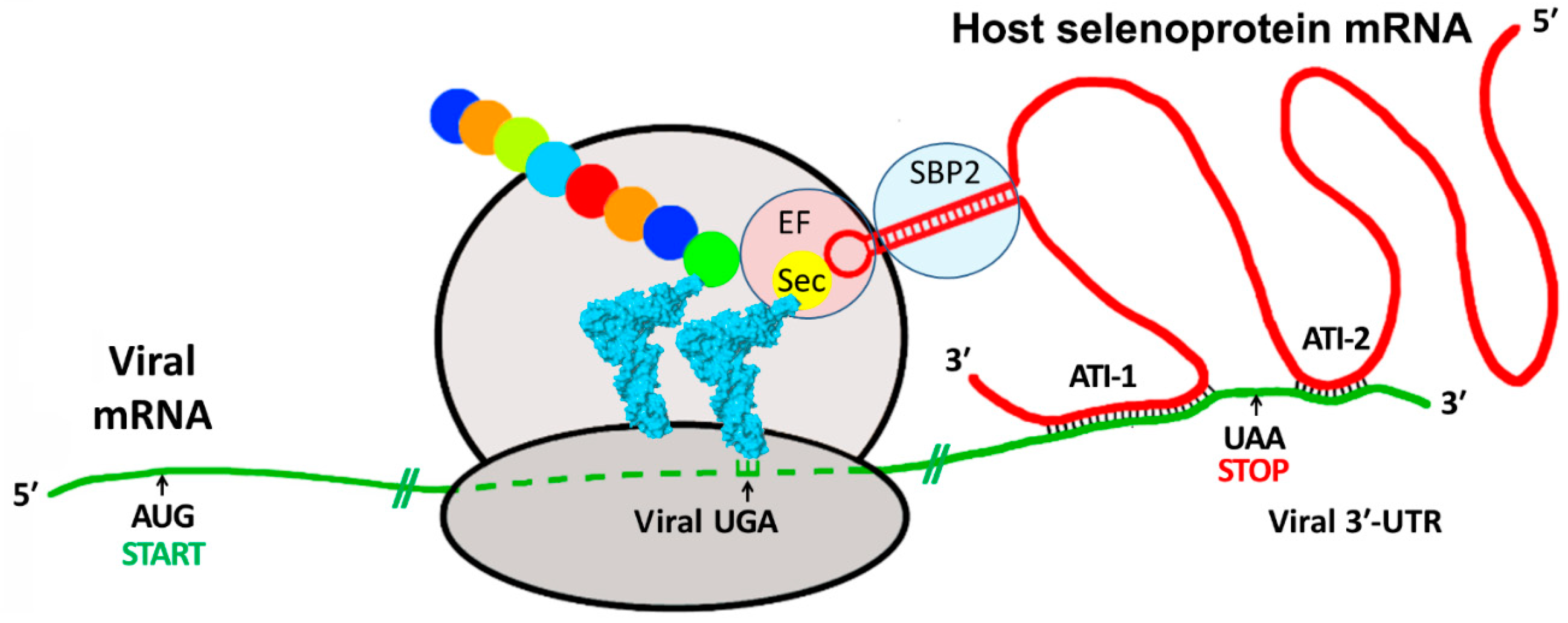
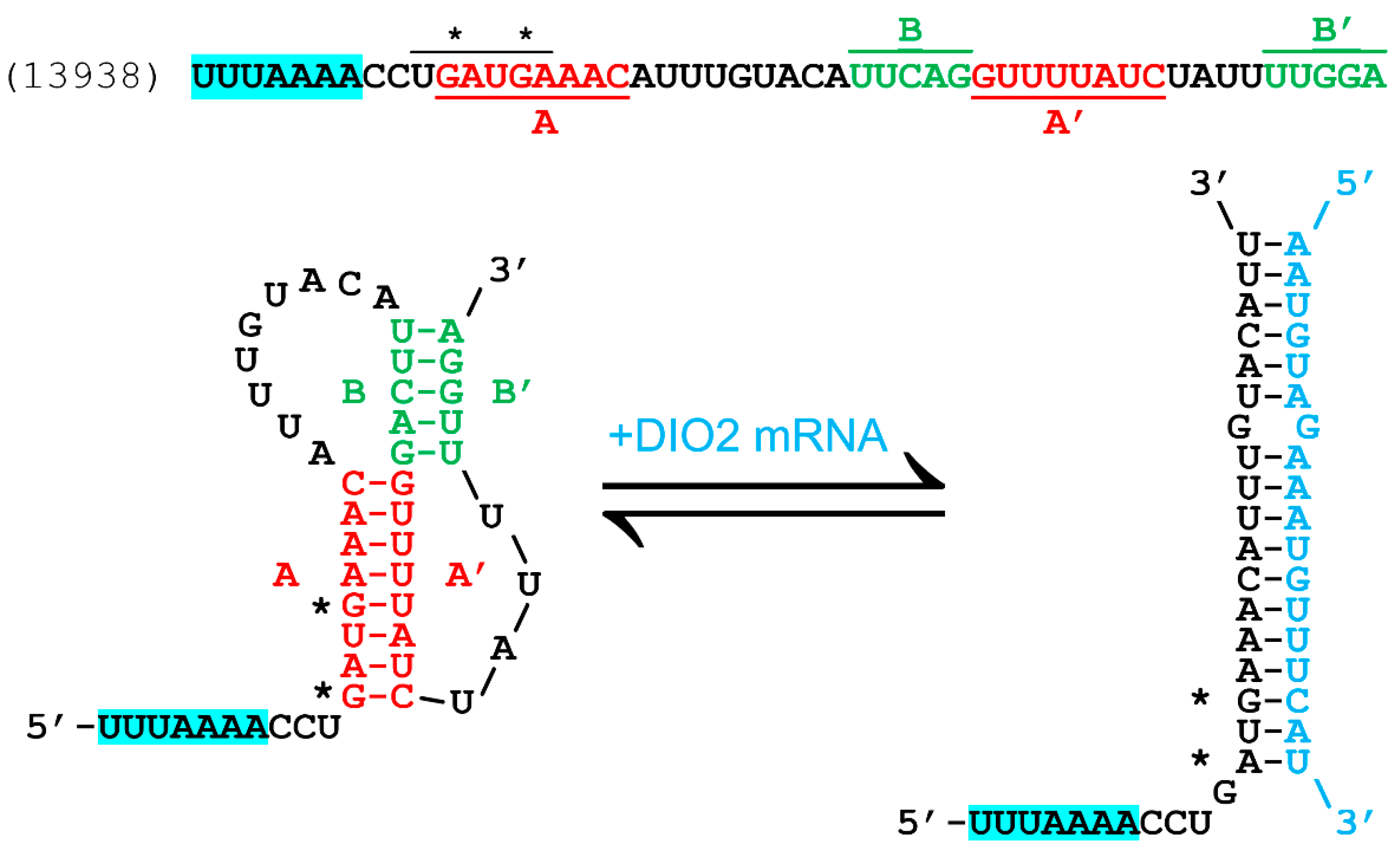


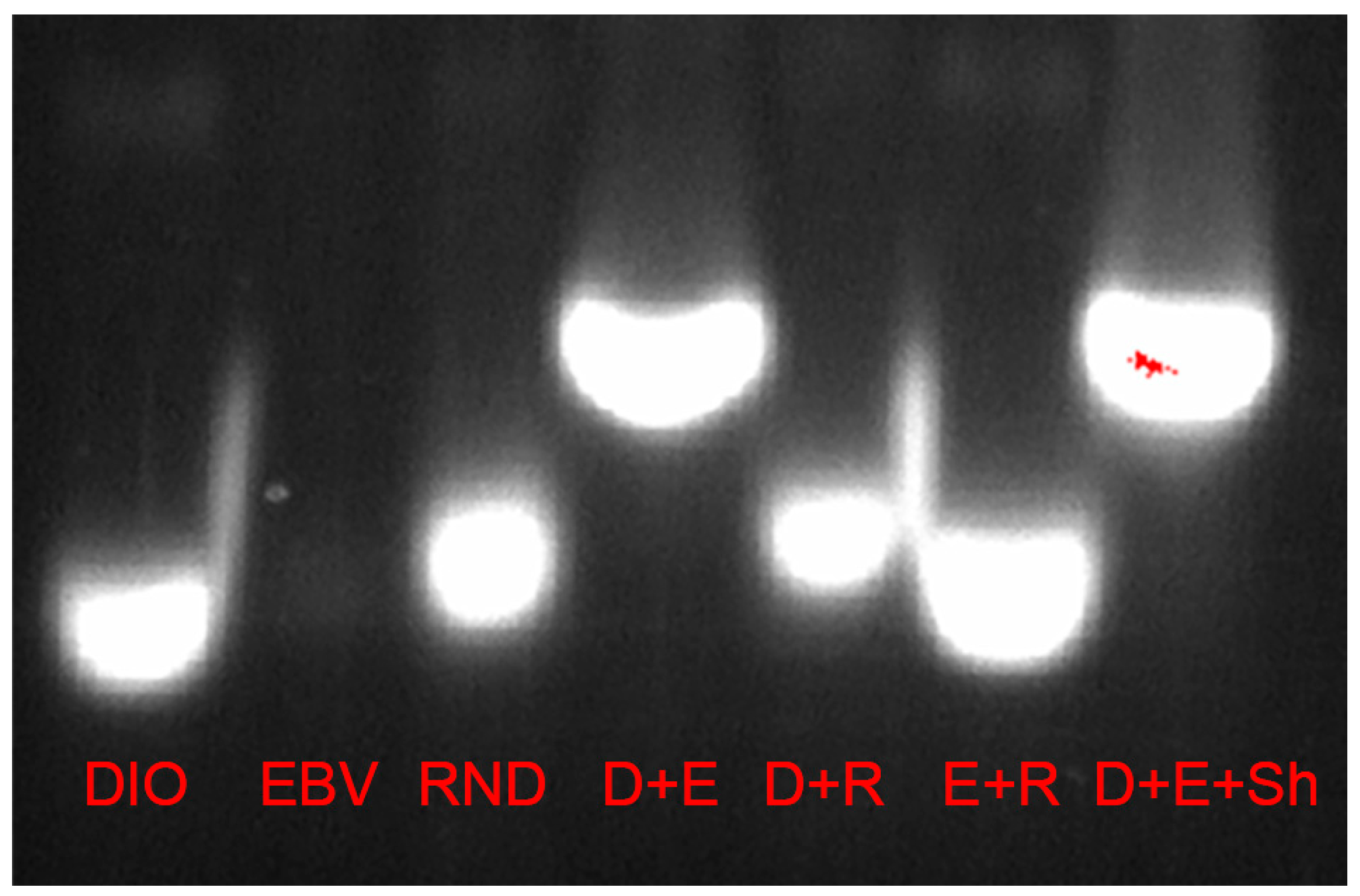

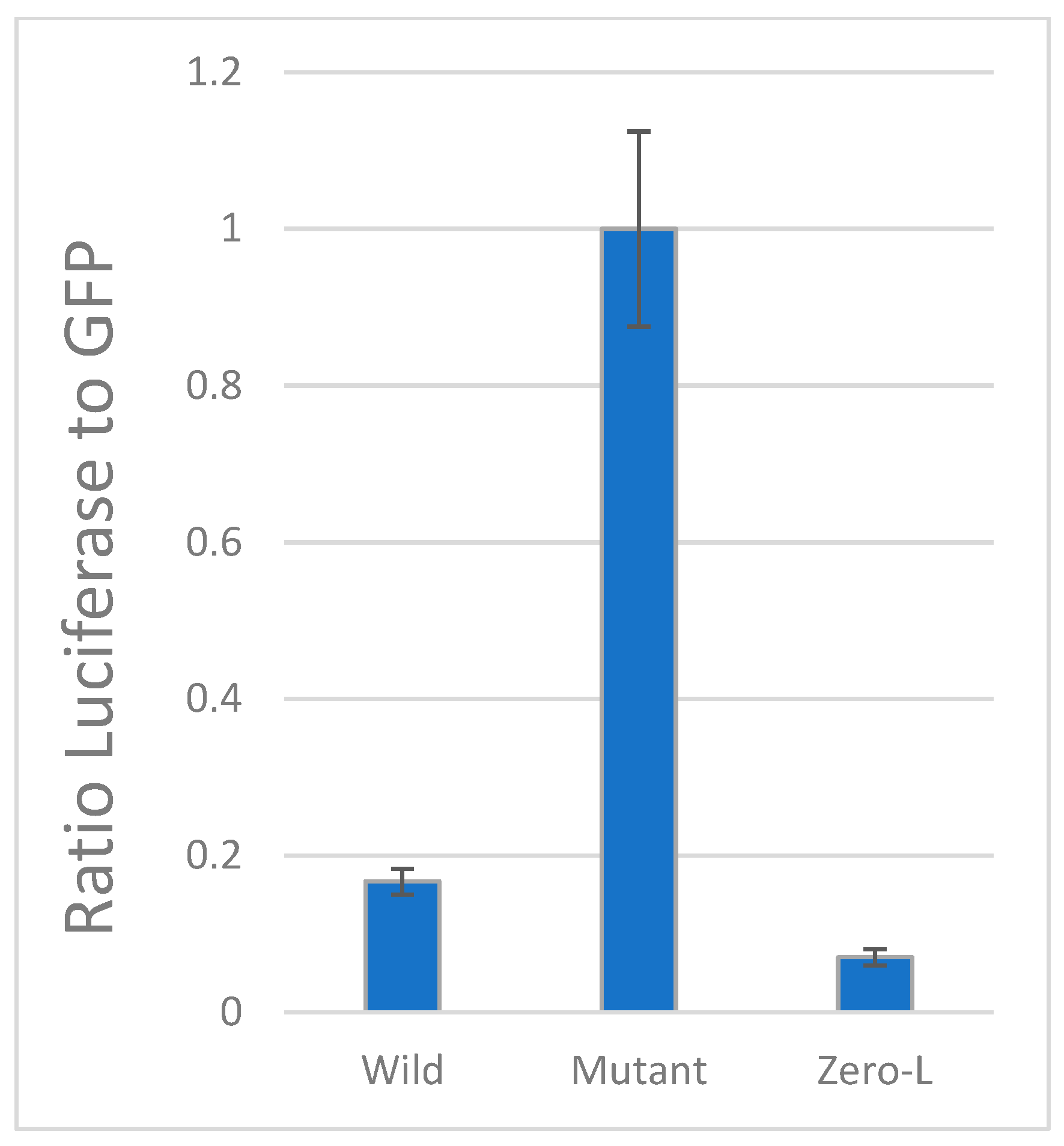
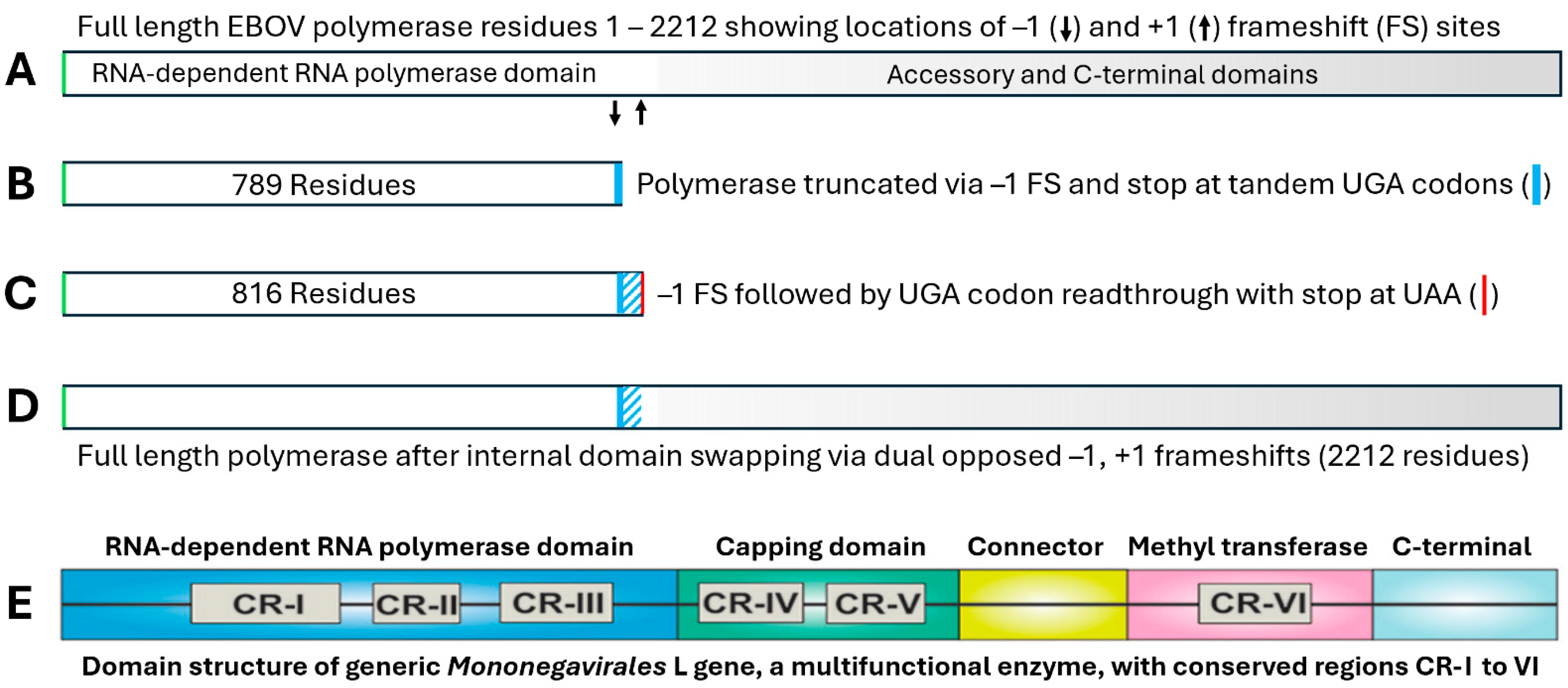
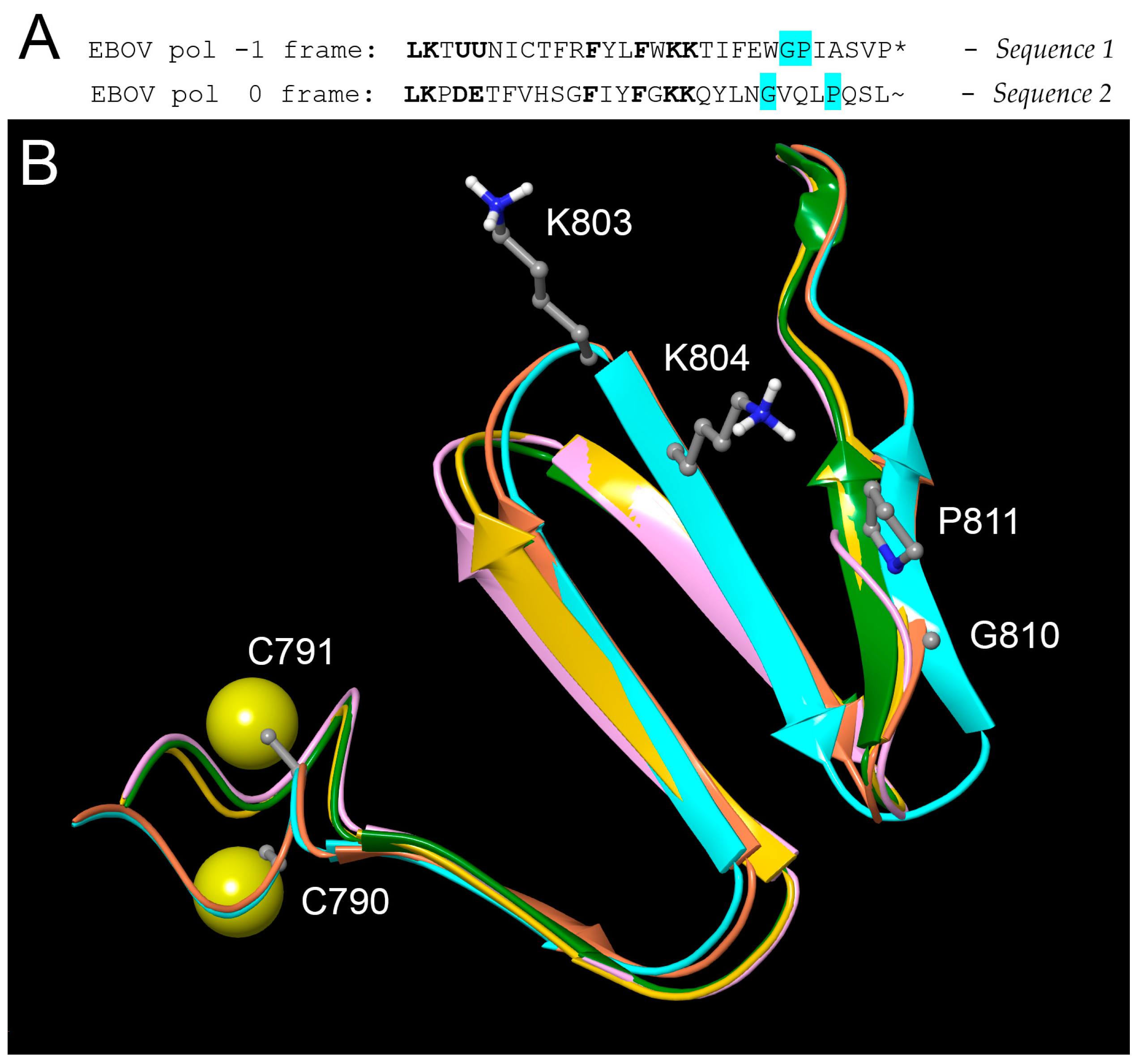
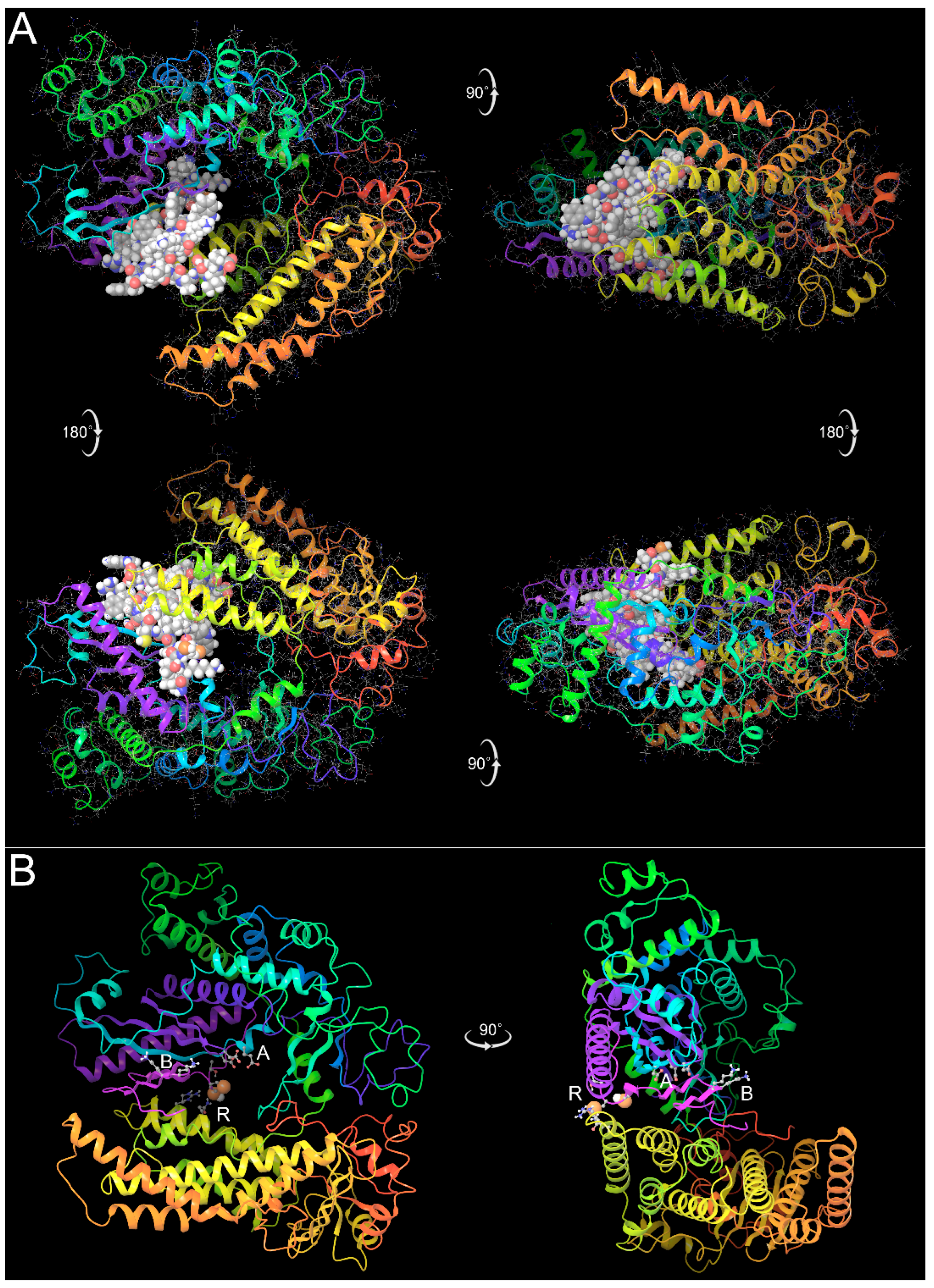
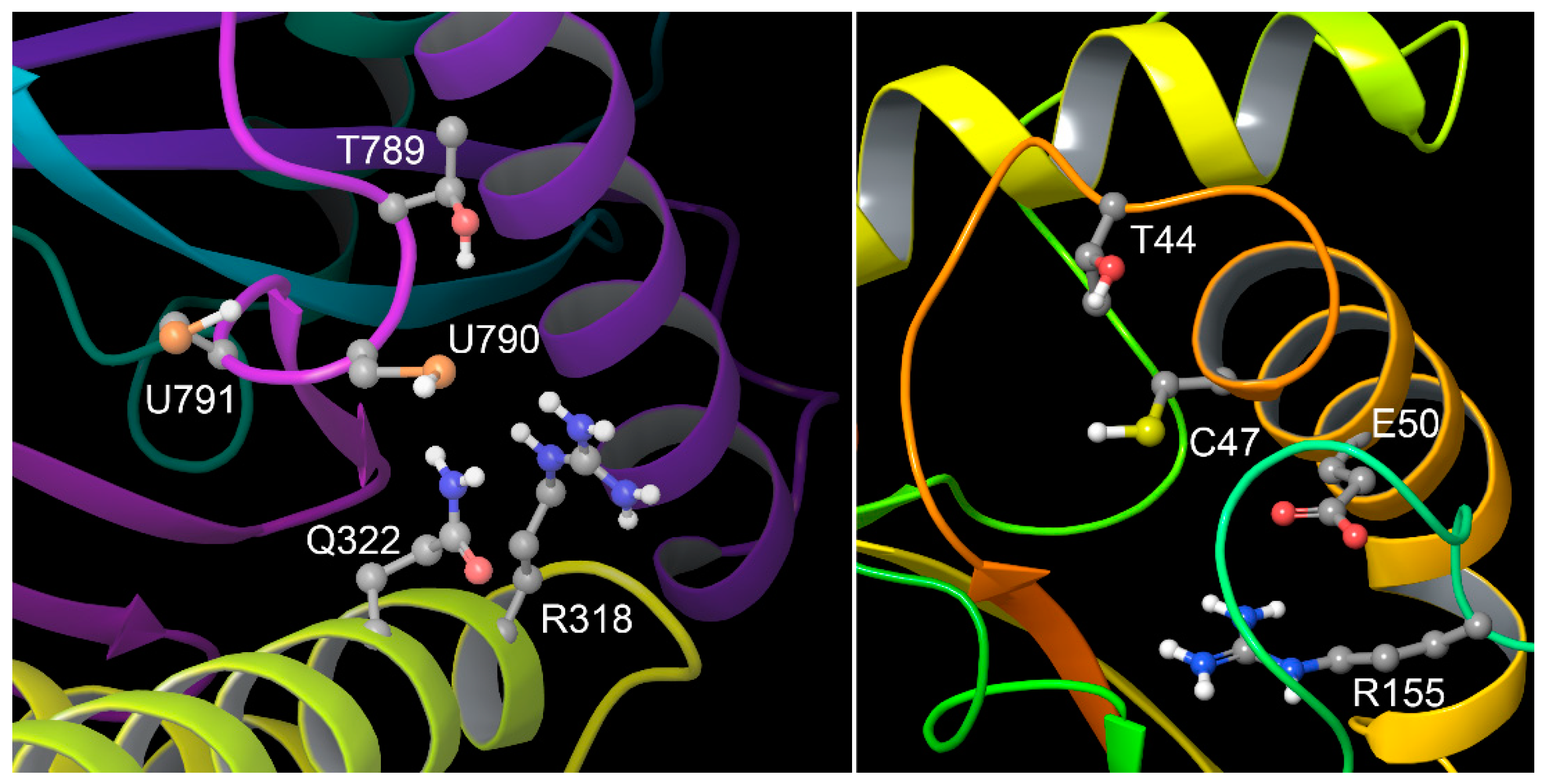
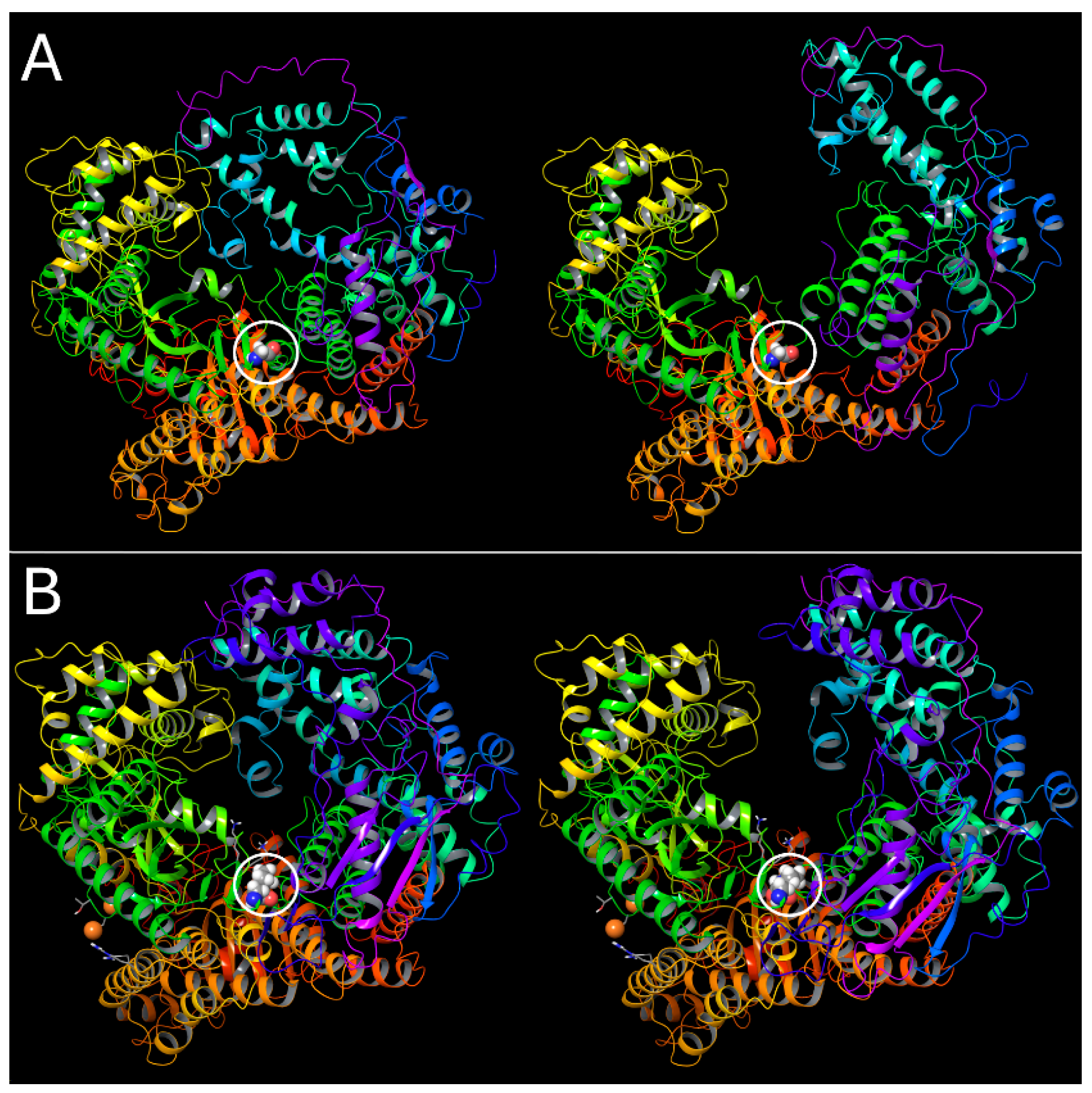
| EBOV L Gene Sequence Used as BLAST Query | Position in EBOV Genome | Predicted Role in Formation or Function of L Gene FS Isoforms | Percentage of 483 EBOV Strains Showing 100% Identity to Query |
|---|---|---|---|
| TTTAAAACCTGATGAAACATTTGTACATT 29-mer | 13938-66 | −1 FS slippery sequence (TTTAAAA), tandem TGA codons and anti-DIO2 antisense sequence | 99.8% (482/483) * |
| CCGATTCTTAACACAAATGC 20-mer | 12531-50 | Arg (CGA) and Gln (CAA) codons forming part of peroxiredoxin-like site | 100% |
| GGGGTCCAATTGCCYCAGTCCCTTAA 26-mer Y = C or T, does not affect hinge or frameshift residues | 14005-30 | Hinge residue Gly 809 in zero frame (GGG), Gly–Pro in −1 frame (GGTCCA) and +1 FS hexamer (CCTTAA) | 100% 74% Y = C 26% Y = T |
Disclaimer/Publisher’s Note: The statements, opinions and data contained in all publications are solely those of the individual author(s) and contributor(s) and not of MDPI and/or the editor(s). MDPI and/or the editor(s) disclaim responsibility for any injury to people or property resulting from any ideas, methods, instructions or products referred to in the content. |
© 2024 by the authors. Licensee MDPI, Basel, Switzerland. This article is an open access article distributed under the terms and conditions of the Creative Commons Attribution (CC BY) license (https://creativecommons.org/licenses/by/4.0/).
Share and Cite
Stubbs, D.B.; Ruzicka, J.A.; Taylor, E.W. Modular Polymerase Synthesis and Internal Protein Domain Swapping via Dual Opposed Frameshifts in the Ebola Virus L Gene. Pathogens 2024, 13, 829. https://doi.org/10.3390/pathogens13100829
Stubbs DB, Ruzicka JA, Taylor EW. Modular Polymerase Synthesis and Internal Protein Domain Swapping via Dual Opposed Frameshifts in the Ebola Virus L Gene. Pathogens. 2024; 13(10):829. https://doi.org/10.3390/pathogens13100829
Chicago/Turabian StyleStubbs, David B., Jan A. Ruzicka, and Ethan W. Taylor. 2024. "Modular Polymerase Synthesis and Internal Protein Domain Swapping via Dual Opposed Frameshifts in the Ebola Virus L Gene" Pathogens 13, no. 10: 829. https://doi.org/10.3390/pathogens13100829
APA StyleStubbs, D. B., Ruzicka, J. A., & Taylor, E. W. (2024). Modular Polymerase Synthesis and Internal Protein Domain Swapping via Dual Opposed Frameshifts in the Ebola Virus L Gene. Pathogens, 13(10), 829. https://doi.org/10.3390/pathogens13100829






